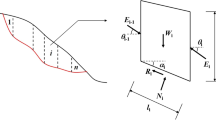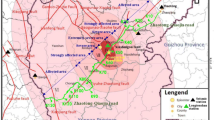Abstract
Unlike the limit equilibrium method (LEM), with which only the global safety factor of the landslide can be calculated, a local safety factor (LSF) method is proposed to evaluate the stability of different sections of a landslide in this paper. Based on three-dimensional (3D) numerical simulation results, the local safety factor is defined as the ratio of the shear strength of the soil at an element on the slip zone to the shear stress parallel to the sliding direction at that element. The global safety factor of the landslide is defined as the weighted average of all local safety factors based on the area of the slip surface. Some example analyses show that the results computed by the LSF method agree well with those calculated by the General Limit Equilibrium (GLE) method in two-dimensional (2D) models and the distribution of the LSF in the 3D slip zone is consistent with that indicated by the observed deformation pattern of an actual landslide in China.
Similar content being viewed by others
References
Alemdag S, Akgun A, Kaya A, et al. (2014) A large and rapid planar failure: causes, mechanism, and consequences (Mordut, Gumushane, Turkey). Arabian Journal of Geosciences 7: 1205–21. DOI: 10.1007/s12517-012-0821-1
Alemdag S, Ayberk K, Mustafa K, et al. (2015) Utilization of the limit equilibrium and finite element methods for the stability analysis of the slope debris: An example of the Kalebasi District (NE Turkey). Journal of African Earth Sciences 106: 134–146. DOI: 10.1016/j.jafrearsci.2015.03.010
Anagnosti P (1969) Three-dimensional stability of fill dams. In: Proceedings 7th international conference on soil mechanics and Foundation Engineering, Mexico City, 1969, vol. 2, pp 275–280.
Baker R (1980) Determination of the critical slip surface in slope stability computations. International Journal for Numerical and Analytical Methods in Geomechanics 4(4): 333–359.
Baligh MM, Azzouz AS (1982) End effects on stability of cohesive slopes. Journal of Geotechnical Engineering Division (ASCE) 101(11): 1105–1117.
Chen RH, Chameau JL (1982) Three-dimensional limit equilibrium analysis of slopes. Geotechnique 33(1): 31–40.
Duncan JM (1996) Limit equilibrium and finite element analysis of slopes. Journal of geotechnical engineering 17(122): 577–596. DOI: 10.1061/(ASCE)0733-9410(1996)122: 7(577)
Fairhurst C (1964) On the validity of the brazilian test for brittle materials. International Journal of Rock Mechanics and Mining Science 1(1): 535–546.
FLAC-3D (2005) User’s Guide: fast Lagrangian analysis of continua in 3 dimensions-version 3.0. Itasca Consulting Group Inc, Minnesota, USA.
Hoek E, Bray J (1981) Rock slope engineering. Institute of Mineral and Metallurgy, London, UK.
Huang CC, Tsai CC, Chen YH (2002) Generalized method for three-dimensional slope stability analysis. Journal of Geotechnical and Geoenvironmental Engineering 128(10): 836–848. DOI: 10.1061/(ASCE)1090-0241(2002)128:10(836)
Hutchinson JN (1982) Methods of locating slip surface in landslides. British Geomorphological Research Group, London, UK.
Jaeger C (1965) The Vajont rock slide. Water Power 4(17): 142–144.
Jaiswal P, Cees JW, Victor J (2011) Quantitative assessment of landslide hazard along transportation lines using historical records. Landslides 8: 279–91. DOI: 10.1007/s10346-011-0252-1
Kahatadeniya KS, Pruettha N, Krishna MN (2009) Determination of the critical failure surface for slope stability analysis using ant colony optimization. Engineering Geology 108: 133–41. DOI: 10.1016/j.enggeo.2009.06.010
Krahn J (2003) The limits of limit equilibrium analyses. Canadian geotechnical journal 40: 643–660. DOI: 10.1139/T03-024
Kaya A, Alemdag S, Dag S et al. (2016) Stability assessment of high-steep cut slope debris on a landslide (Gumushane, NE Turkey). Bulletin of Engineering Geology and the Environment 75: 89–99. DOI: 10.1007/s10064-015-0753-6
Leshchinsky D, Huang CC (1992) Generalized three-dimensional slope-stability analysis. Journal of Geotechnical Engineering (ASCE) 118(11): 1748–1764.
Mankelow JM, Murphy W (1998) Using GIS in the probabilistic assessment of earthquake triggered landslide hazards. Journal of Earthquake Engineering 2(4): 593–623.
Colomer MFJ, Gisbert AF, Izquierdo AG, et al. (2009) Safety factor nomograms for homogeneous earth dams less than ten meters high. Engineering Geology 105: 231–38. DOI: 10.1016/j.enggeo.2009.01.001
Morgenstern NR, Price VE (1965) The analysis of the stability of general slip surfaces. Geotechnique 1(15): 79–93.
Morgenstern NR, Price VE (1967) A numerical method for solving the equations of stability of general slip surfaces. The Computer Journal 9: 388–93.
Nguyen V (1985) Determination of critical slope failure surfaces. Journal of Geotechnical Engineering 111(2): 238–250.
Okubo S, Fukui K, Nishimatsu Y (1997) Local safety factor applicable to wide range of failure criteria. Rock Mechanics and Rock Engineering 30(4): 223–227. DOI: 10.1007/BF01045718
Ono K (1962) On the load of materials. Transactions of Society of Materials Engineering 16(29): 37–48.
Ozbay A, Cabalar AF (2015) FEM and LEM stability analyses of the fatal landslides at Collolar open-cast lignite mine in Elbistan, Turkey. Landslides 12: 155–163. DOI: 10.1007/s10346-014-0537-2
Irons BM (1971) Quadrature rules for brick based finite elements. International Journal for numerical methods in Engineering, 3: 293–294.
Srbulov M (1987) Limit equilibrium method with local factors of safety for slope stability. Canadian Geotechnical Journal 24(4): 652–656.
Van Westen CJ (1994) GIS in landslide hazard zonation: a review, with examples from the Andes of Colombia. In: Price MF, Heywood DI (Eds.), Mountain Environments & Geographic Information Systems, Chapter: GIS in Landslide Hazard Zonation: A Review, with Examples from the Andes of Colombia. Publisher: Taylor and Francis, pp.135-166.
Wang LT, Zhou WH (1982) Stability analysis of rockmass at the Arc Dam Abutment. Guizhou People Press, Guiyang, China.
Werner ED, Friedman HP (2009) Landslides: Causes, Types and Effects. Nova Science Publishers, New York, USA.
Xu JC (2011) Debris slope stability analysis using three-dimensional finite element method based on maximum shear stress theory. Environmental Earth Sciences 64: 2215–22. DOI: 10.1007/s12665-011-1049-1
Yao BK, Sun YK, Liu ZH (1984) Stability analysis of slip mass in slopes under the geotechnical stress. Metal mine 4: 16–20.
Zheng H (2012) A three-dimensional rigorous method for stability analysis of landslides. Engineering Geology 145-146: 30–40. DOI: 10.1016/j.enggeo.2012.06.010
Author information
Authors and Affiliations
Corresponding author
Additional information
http://orcid.org/0000-0001-5072-7089
http://orcid.org/0000-0003-1011-0409
http://orcid.org/0000-0002-4098-1419
Rights and permissions
About this article
Cite this article
Yang, T., Yeung, Mc.R., Yang, B. et al. Three-dimensional stability of landslides based on local safety factor. J. Mt. Sci. 13, 1515–1526 (2016). https://doi.org/10.1007/s11629-016-3918-2
Received:
Revised:
Accepted:
Published:
Issue Date:
DOI: https://doi.org/10.1007/s11629-016-3918-2




